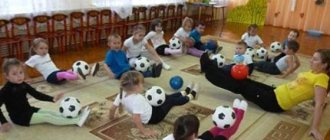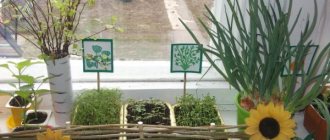The use of fiction in kindergarten classes is a powerful means of developing a harmonious personality. Reading helps improve a child's mental, aesthetic, speech abilities and skills. In the second younger group, more and more attention needs to be paid to reading, to cultivate a love of books. The lesson process itself can be structured in completely different ways - it depends on the tasks set and the topic of the chosen work.
- 2 How to read with children of the second youngest group
2.1 Organization of reading using the example of the Russian folk tale “Kolobok” - 2.2 Table: long-term plan for fiction (fragment, author Natalya Aleksandrovna Artyukhova)
- 2.3 Table: examples of GCD notes in the second junior group in fiction
The benefits of reading fiction for children 3–4 years old
In children aged 3–4 years, there is an active development of imagination and cognitive processes. The child is already able to emotionally evaluate and comprehend the texts of works: empathize with the characters, give an assessment, and draw conclusions.
Reading fiction develops imaginative thinking, fosters a love of reading, nature, and the world around us. Collective reading in a group helps the teacher to open up for children the world of relationships between people, the features of life in society.
Reading fiction develops imaginative thinking
Reading books is the path along which a skillful, intelligent, thinking teacher finds the way to a child’s heart.
V.A. Sukhomlinsky
The following goals for reading classes in the second junior group are set:
- developing a complete picture of the world;
- development of speaking skills;
- continued acquaintance with the artistic word;
- developing the ability to construct answers to questions;
- development of perception of artistic images;
- introduction to the culture of reading, the formation of a love for books;
- development of emotional reaction to events in works of art.
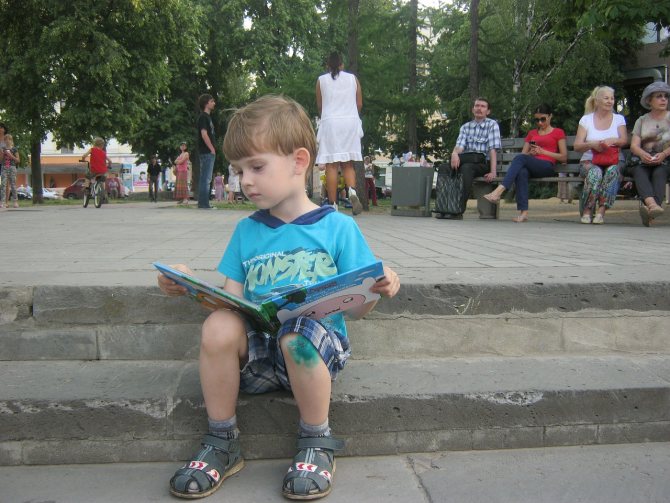
Books help children explore and understand the world around them
The objectives of a specific lesson may be:
- introducing children to literary works, meeting new writers;
- replenishment of vocabulary, familiarization with new words;
- developing the skill of expressive reading and intonation;
- expanding knowledge about the world around us (for example, getting to know professions while studying S. Mikhalkov’s poem “What do you have?”).
How to read with children of the second youngest group
In the second junior group, it will be useful to use the following techniques in the classroom:
- artistic expression - reading a text;
- teacher's story - here you can read the text or retell it, using various means to help: toys, puppet theater, pictures, filmstrips;
- learning by heart;
- individual reading and choral speaking;
- combining two types of arts - viewing pictures, listening to music while reading;
- staging (for example, acting out the fairy tale “Turnip” using finger toys or figurines);
- didactic games.
Should be read to children daily. There must be a book corner to which children will have constant access. There you need to place several books studied according to the program, as well as books recommended for study in your free time. At the age of 3-4 years, daily reading before bed after lunch is mandatory.
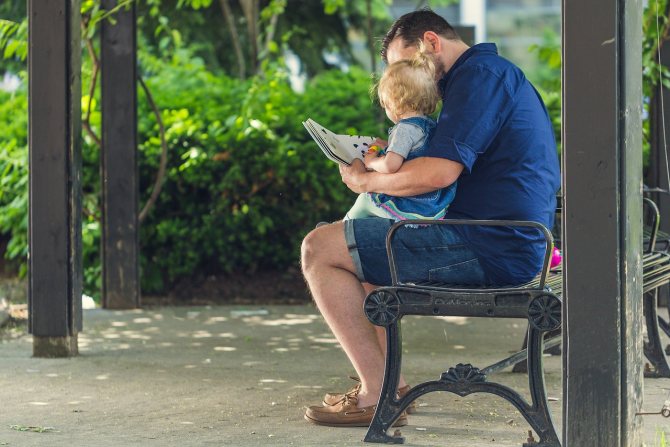
It’s better when parents also support their child’s involvement in reading.
Before reading a work to children, the teacher should read it himself and analyze it. Here you need to pay attention to the following points:
- Determine what the child can understand on his own in the book, and what needs to be explained for better assimilation.
- Mark passages and words in the text that will help develop speech when they are repeated (for example, the teacher reads the passage: “Little goats, kids! Open up, open up! Your mother came and brought milk...” (“The Wolf and the Seven Little Kids”), then reads some more times the phrase and asks the guys to finish it).
- Intonation moment: the teacher should highlight emotional moments with intonation.
- Selection of illustrations for the book.
Conducting a more comfortable lesson without overloading children with unnecessary information and fatigue will be facilitated by:
- changing teaching techniques with game ones (for example, after reading S. Marshak’s poem “The Tale of a Stupid Mouse,” you can play the game “Find the Mouse”);
- alternation of group and individual responses of children (both verbal and motorically expressed);
- inclusion of demonstration materials (toys, figurines, drawings, etc.) into the lesson - this pleases the kids and helps focus their attention;
- using actions that will require the children to change their position, move (for example, “Children, let’s look where the cat hid” - and look under chairs and tables). This technique significantly enlivens the activity, enlivens the child’s imagination and prevents fatigue.
Organization of reading using the example of the Russian folk tale “Kolobok”
The objectives of the lesson are to introduce the children to the fairy tale “Kolobok” and teach them word formation.

It is easier for children of primary preschool age to perceive text accompanied by illustrations
The lesson can be structured as follows:
- Introductory part. The teacher conducts a conversation with the children, asks who Kolobok is, whether the children have heard of him before (from home reading, cartoons).
- Then reading an excerpt from a fairy tale: “I kneaded the dough with sour cream, rolled it into a bun...” (kids demonstrate with their hands how to make a bun).
- Expressive reading of a fairy tale (here it is worth emotionally highlighting the moments of joy when Kolobok manages to escape from the animals so that the children rejoice, and the moment of grief when the fox deceived him with her cunning).
- The teacher repeats with the children what different animals said to the kolobok (“Kolobok, kolobok, I’ll eat you!”).
- Word game (“Guys, now let’s play! I will tell you words that denote a large object, and you will say words that denote the same objects, only smaller: table - table, cup - cup”).
- Then the teacher shows the children drawings for the fairy tale “Kolobok”, saying that many famous artists have depicted Kolobok.
The teacher must make full use of the necessary methodological techniques for mastering the material, developing listening skills, and reading comprehension. Expressive reading of a work helps children better remember the material and evaluate it. When discussing what you read, you can use a comparison of a situation in a book with a comparison of a real-life incident, and give hints when answering.
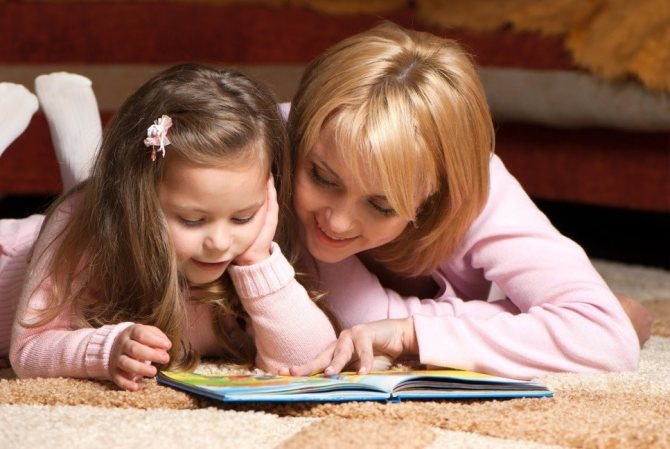
Expressive reading will help you remember the material better
When choosing a topic for a lesson, it will be very useful to associate it with some holiday or time of year for the children to better assimilate the material.
Table: long-term plan for fiction (fragment, author Natalya Aleksandrovna Artyukhova)
| Month | Subject | What are the lessons aimed at? |
| September | Poem “The Preacher” by Sasha Cherny |
|
| Russian folk tale "Cat, Rooster and Fox" |
| |
| Russian folk tale "Three Bears" |
| |
| October | Reading the Russian folk tale "Kolobok" |
|
| Reading poems by A. Barto from the “Toys” cycle |
| |
| Reading poems by A. Blok “Bunny” and A. Pleshcheev “Autumn” |
| |
| November | Russian folk nursery rhymes “Kitsonka-murysenka”, “The cat went to market” |
|
| Russian folk tale “Sister Alyonushka and Brother Ivanushka” |
| |
| Reading poems about mom |
| |
| Reading a fairy tale in verse by K.I. Chukovsky "Moidodyr" |
| |
| December | Russian folk tale "Masha and the Bear" |
|
| S.Ya. Marshak "The Tale of a Stupid Mouse" |
| |
| Russian folk tale "The Fox and the Wolf" |
| |
| January | L. Voronkova story “It’s snowing” | Introduce a work of art, reviving in the children’s memory their own impressions of the snowfall. |
| Russian folk tale "The Snow Maiden and the Fox" |
| |
| E. Charushin story “Wolf” |
| |
| February | Russian folk tale "The Wolf and the Seven Little Goats" |
|
| Z. Aleksandrova’s poem “My Teddy Bear” |
| |
| Russian folk tale "Rukavichka" |
| |
| Russian folk tale "The Cockerel and the Bean Seed" |
| |
| March | E. Blaginina, poem “This is what a mother is like” |
|
| Reading of A. Pleshcheev’s poem “Spring” |
| |
| Russian folk tale “Fear has big eyes” |
| |
| L. N. Tolstoy's story “Truth is more precious than anything else” |
| |
| April | Reading the Russian folk tale "Geese and Swans" |
|
| K. Chukovsky reading the story “Chicken” |
| |
| Russian folk tale “Bull-black barrel, white hooves” |
| |
| May | Reading the story “Holiday” by Ya. Taits |
|
| V. V. Mayakovsky “What is good - what is bad?” |
| |
| S. Marshak poem “Children in Cages” |
|
In pedagogical practice, there is a huge amount of materials to help teachers conduct classes.
Table: examples of GCD notes in the second junior group in fiction
| Author and title of the abstract | Description of material |
| Tatiana Osipova. “Reading the Russian folk tale “Geese and Swans” | Notes on reading the Russian folk tale “Geese and Swans” (aimed at the general artistic development of children, and also serves other educational purposes). |
| Ksenia Yakovleva. “Reading the fairy tale “The Wolf and the Seven Little Goats” | The notes will help in planning a fairy tale reading lesson, the purpose of which is to instill in children a love for animals and teach them to empathize with them. |
| Olga Yantsen. “Reading the fairy tale “Kolobok” | The summary is aimed at developing spoken language in children of the second younger group. |
| Galina Kochulova. Integrated lesson in the second junior group on familiarization with fiction “Teremok” | Lesson summary using non-traditional appliqué technique (“Palms”). |
MAGAZINE Preschooler.RF
Project in the second junior group “Reading together”Author: Elena Gennadievna Postnova, Olga Andreevna Siforova.
Description: The book is a source of knowledge! Children who read usually grow up with parents who read. In order to revive family reading, this project was developed, designed for children 3-4 years old and their families.
Educational area: cognitive development, artistic and aesthetic development, speech development, social and communicative development.
Project type: practice-oriented.
Project type: complex.
Relevance of the topic: Unfortunately, today parents do not pay enough attention to reading their children. Interest in the book has decreased. Parents don’t know what books they can recommend to their child, and if they recommend it, it’s books that they themselves read in childhood, but they are not always of interest to modern children. Without reading, children hardly develop the habit of focused attention and the ability to work intellectually. A dislike for reading that arose in childhood and difficulties in perceiving text, as a rule, accompany a person throughout his life.
Family reading is of particular importance for a child’s reading destiny. Preschool children are listeners, so parents need to read to their children as much as possible. Listening to an adult read, looking at book illustrations with him, the child actively thinks, worries about the characters, he develops bright, imaginative, colorful, grammatically correct speech, and there will be a desire for constant communication with the book.
Project participants: pupils of the second junior group, teachers, parents.
Duration of the project: short-term, March 25 – April 5.
Objective of the project:
- in the revival, starting from an early age, of the tradition of joint family reading;
- in introducing the child to the book, to the process of reading and thinking about its contents;
- in creating a family library, including using book exchange technology
Project objectives:
- to intensify the work of parents to promote and develop reading in the family;
- contribute to maintaining family reading traditions and enriching the home library;
- cultivate partnership and friendly relationships with children, parents, and teachers.
- cultivate high moral qualities and respect for books;
- increase the efficiency of introducing children to books in the interaction of all participants in the educational process: teachers, children, parents.
Participation of parents in the implementation of the project: ensuring continuity in raising a child in a child care institution and in the family. Involving parents in joint activities with children and teachers.
Project implementation plan:
- Questioning parents: “Child and book”
- Conversation: “Books are best friends”
- Consultation for parents: “Reading with your child”
- Proverbs and sayings about the book.
- Riddles about the book.
- Poems about the book.
- Promotion: “Give children a book”
- Role-playing games: “Bookstore” , “Book Workshop” ,
"Library"
- Getting to know the works of children's writers
- Reading fiction by Russian and foreign authors
- Family Library “Read to us, parents!”
Expected result:
- increasing the activity of parents in the life of the child and the group;
- creation of a book exhibition;
- awareness by every parent of the value of children's reading as an effective means of education and upbringing;
- popularization of family reading as a source of developing interest in books
Conversation in junior group 2 on the topic “Books are best friends”
Tasks:
- To foster in children an interest and love for books;
- develop speech activity, skills in verbal description and illustrations;
- identify familiar books and fairy tales.
Move
State budgetary preschool educational institution kindergarten No. 52, Kolpinsky district of St. Petersburg
Project “Books are the best friends!”
(increasing reading interest in children by creating a library in the reception group)
Prepared and conducted by: Chelnokova O.S. St. Petersburg, Kolpino 2020
Project type: communicative-creative, children's and family.
By number of participants: group.
Project participants: children of the second junior group, teachers, parents.
Project duration: 1.5 months
Problem: Not enough attention is paid to reading within the family.
Goal: To help parents realize the value of children's reading as an effective means of education and upbringing of preschoolers.
Tasks:
To encourage children to develop an interest in books and works of fiction.
To create a desire for joint child-parent reading.
Develop elements of creativity, teach how to use what they read in other types of children’s activities (play, productivity, communication with adults).
To instill in children and parents a love and respect for books.
Bring your family together through reading fiction.
Expected Result:
- Revival of the tradition of home reading.
- Increasing the competence of family members in raising a literate reader.
Project product:
- Creating a library in the reception group
- Bookmarks
- Baby book (joint work of parents and children)
Relevance:
Fiction has always been recognized as the main means of comprehensive development of children and affects all aspects of the child’s personality. At the same time, the modern sociocultural situation complicates this process. Our society has turned from a “reading” into a “watching” one . The fading interest in reading and books had a negative impact on adults and, as a result, had a negative impact on children and their personal culture.
Reading together between children and adults and discussing what they read is a fertile ground for the spiritual rapprochement of children and parents. Therefore, we must not forget that parents, by telling or reading to their children, create a warm and cozy atmosphere in the family, which is very important for the all-round development of the child. Unfortunately, many parents nowadays, due to their busyness, devote very little time to reading with their children; many generally consider this activity frivolous, a waste of time, and there are those who simply do not know how to organize home reading. Therefore, an important role in the work of introducing preschoolers to reading fiction is played by the interaction of teachers of a preschool educational organization with the families of their pupils.
Currently, the book is losing an unequal battle with technical means: television and computer. Modern children increasingly spend their free time playing computer games, watching TV shows, especially cartoons, and reading books less and less. And this is understandable, reading is a kind of work in which the child thinks, imagines, and gets used to the image. As for technical means, you don’t have to put in any effort, you don’t have to think, imagine, just sit and watch, and it’s more convenient for parents.
The task of today is to introduce preschool children to reading fiction with the help of their parents. After all, according to the Federal State Educational Standard, they are full participants in the educational process.
Project stages:
I. Stage (preparatory)
- Selection and analysis of methodological literature and Internet resources on the project topic.
- Parent survey.
- Analysis of the survey.
- Video message from library workers.
- Survey of parents regarding registration in the library.
- . Drawing up a work plan for the project.
II. Stage (main)
- Consultation for parents of pupils: “Reading with the child” , “The child and the book” .
- Promotion for parents: “Let’s open a library together”
- Conversation with children: “My favorite book , “Ryaba the Hen , “What kinds of books are there?”
*
4. Selection of proverbs, sayings, riddles, poems about the book.
5. Story-role-playing games: “Book Workshop”
6. Family library: “Read to us, parents!”
7. Together with parents, the production of a “Baby Book” with a rich fairy tale or story.
8. Children’s artistic creativity (drawing): “Favorite fairy tale hero” , (applique) “Bookmark for my book”
9. Selection of didactic games on the topic of the project
III. Stage (final)
- As a result of work on the project, products of children's activities were created: drawings “favorite fairy tale characters” , production together with parents of “Baby Book” , application “Bookmark for my book” made by children.
- The activity of parents in the life of the child and the group has increased.
- Every parent's awareness of the value of children's reading as an effective means of educating and raising a child has increased.
- Popularization of family reading as a source of interest in books.
- Creation of a children's library in the reception group “Read to us, parents!”
Result of the project:
- As a result of the project, children became acquainted with the work of children's poets and writers.
- We learned to recognize fairy-tale characters in reproductions and photographs.
- Children's interest in fiction has increased.
- We met children's book illustrators.
- Thematic exhibitions were organized (Do-it-yourself book “Baby Book” ).
- As part of the project, children learned to take care of books.
- Parents also actively participated in organized events and showed initiative.
- In addition to this, parents actively took part in creating a library in our group.
- The project method aroused cognitive interest in various areas of knowledge, formed cooperation skills: parents-educators - children...
design makes active participants in the educational process, leads to self-development not only of children, but also of parents.
Significance of the project
Thanks to the project, the interaction between the preschool educational institution and the family has expanded, and new areas of cooperation have emerged to introduce children to the wonderful world of poems and fairy tales by children's writers.
Bibliography:
- Arbuzova V.F. Conversation with children “What kind of books are there? ” nsportal. ru
- Karaseni S. V. “Journey into the past of the book . nsportal. ru
- Karpunina O. G. “Knizhkina Hospital” . nsportal. ru
- Polikarpova I. B. Synopsis of the role-playing game “Library” . nsportal. ru
| Next > |
